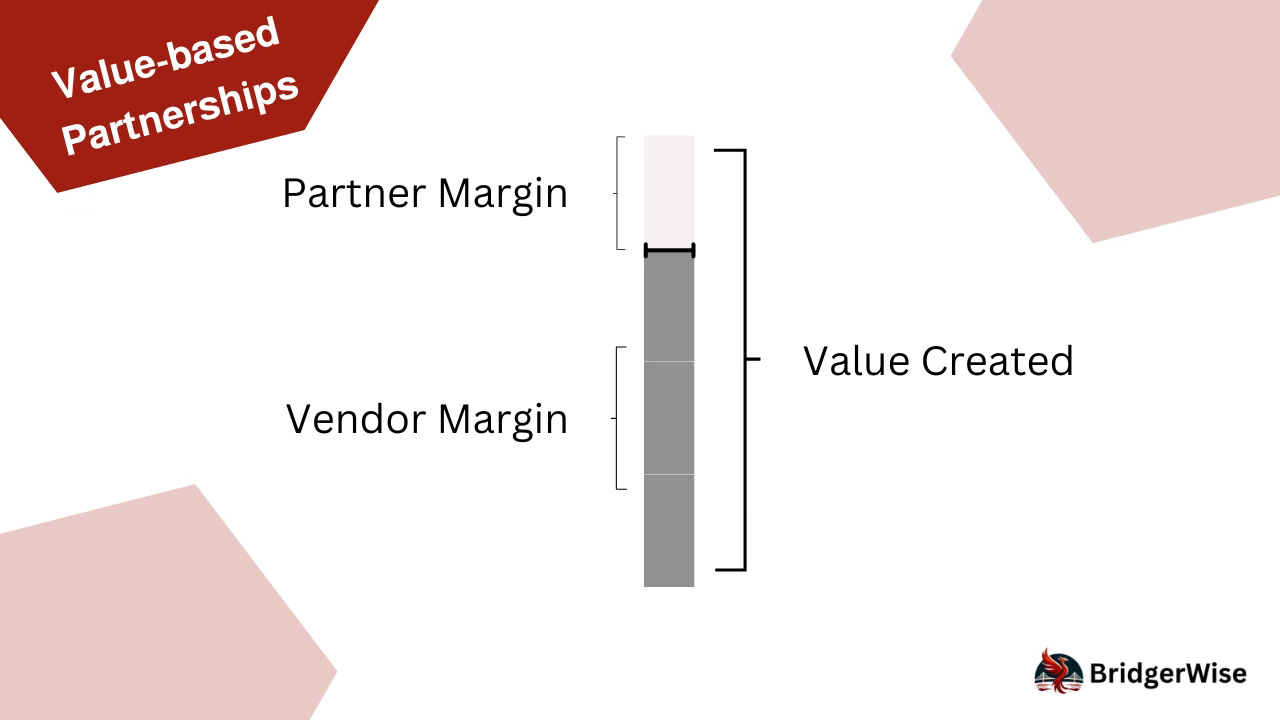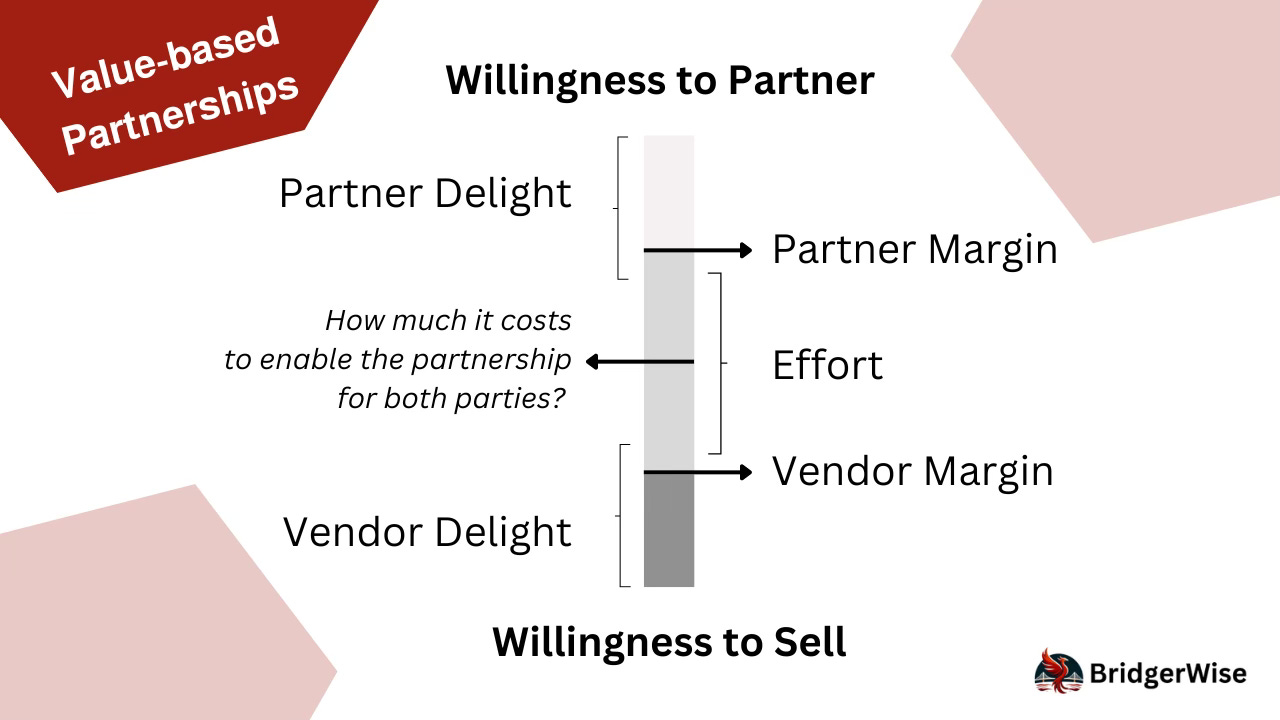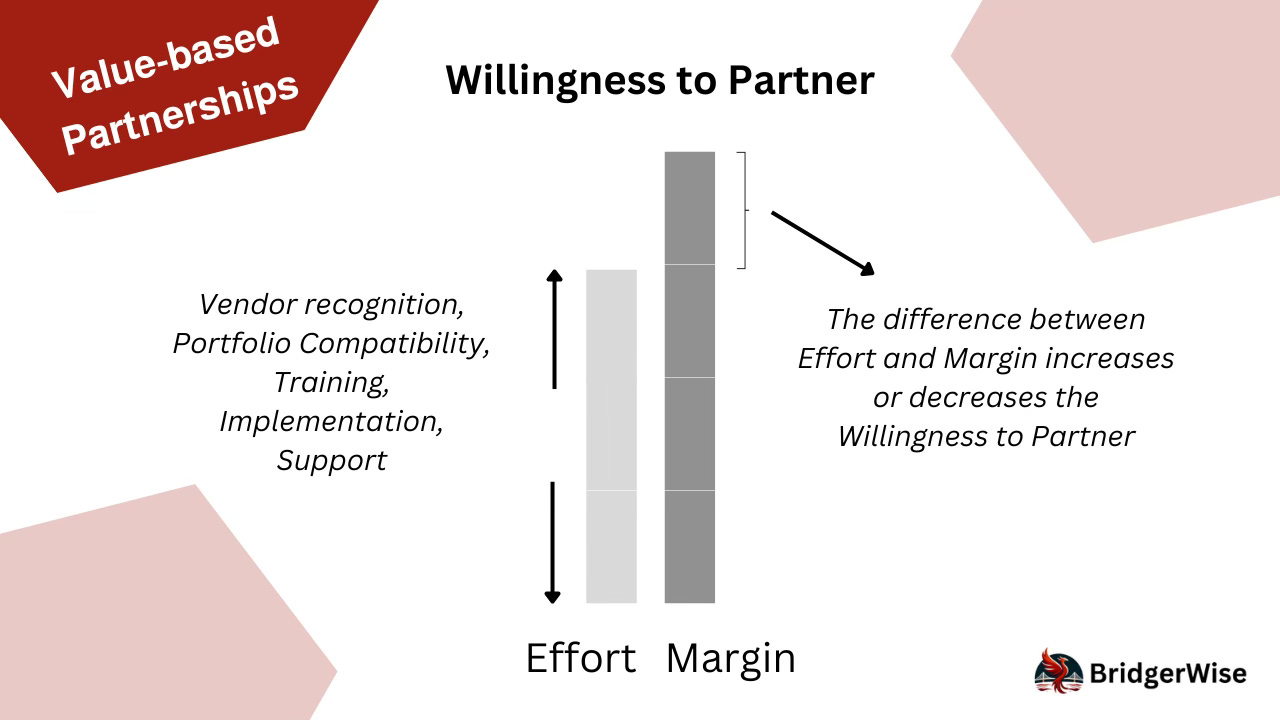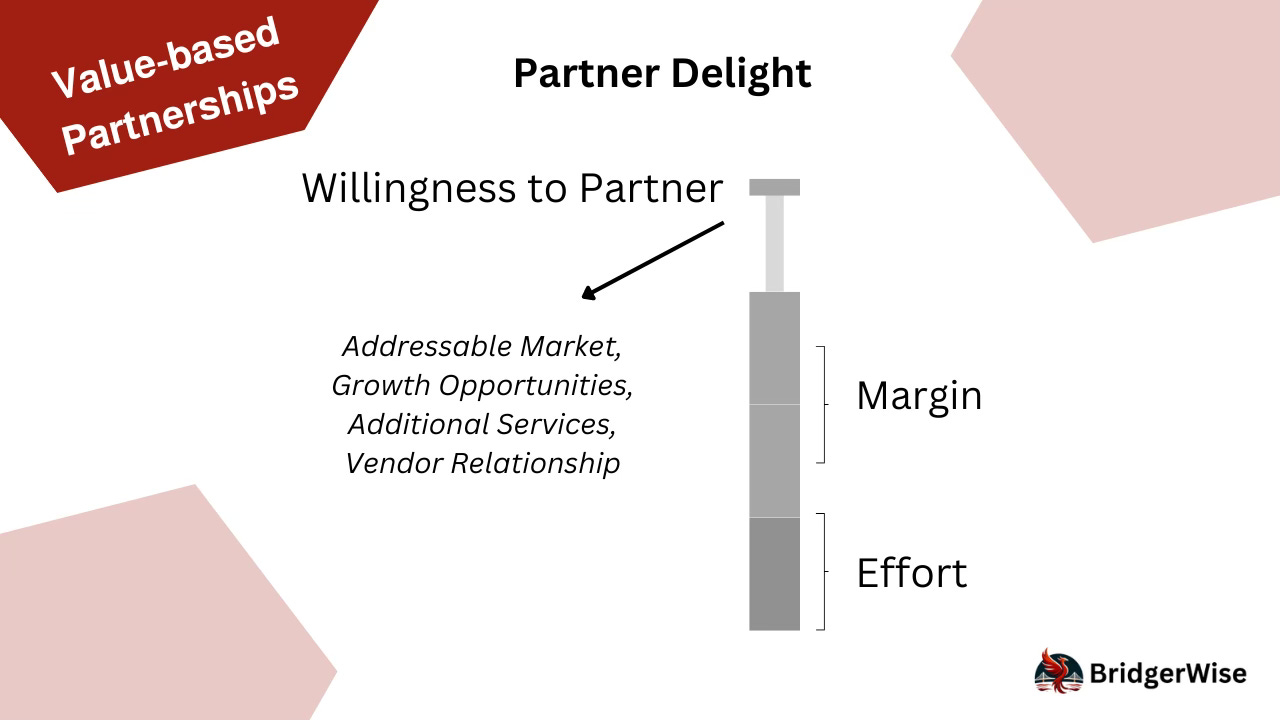Value-Based Partnerships Strategy
Reimagining the Value Stick concept to understand, create and develop strong Vendor-Channel Partner relationships
Value-based strategy is a fundamental concept in business, focusing on understanding and optimizing the value perceived by customers and the value captured by a company. The value stick is a powerful tool within this strategy, helping businesses visualize and manage these aspects to set prices that maximize both customer satisfaction and profitability.
The value stick is typically used to represent the range of value perception and capture in a straightforward manner:
Customer Perceived Value: The top of the stick represents the maximum price a customer is willing to pay for a product or service, based on the perceived benefits compared to alternatives.
Price: Positioned below the customer perceived value, the price is what the company actually charges for its product or service. The difference between the customer perceived value and the price is known as the consumer surplus or delight, representing the additional value perceived by the customer over what they pay.
Cost: At the lower end of the stick, the cost represents the expenses incurred by the company to produce and deliver the product or service.
Value Captured by the Company: The difference between the price and the cost is the company's profit margin, indicating the value captured by the company.
The goal of using the value stick is to find a balance where the customer perceives high value, yet the company captures a significant portion of it through its pricing strategy. By doing so, businesses can enhance customer satisfaction and loyalty while ensuring profitability.
Could we apply the value stick concept to relationships between vendors and their channel partners? Yes, we can, and in this article we are going to re-imagine the value stick and create a framework for value-based partnerships that focuses on mutual benefits and the efforts required from both parties.
How a vendor-channel partner relationship creates value?
When it comes to vendor-channel partner relationships, the value stick can be adapted into a Value-Based Partnerships Strategy. This concept focuses on the value each party brings to the table and the effort needed to setup and maintain a successful partnership.
The relationship between a vendor and a channel partner is usually ruled by a partner program: a set of rules, responsibilities and benefits that defines how the partnership will create value for both parties.
When a vendor sells its products and services through a partner, that’s usually called an indirect channel.
In this scenario, the end customer procures the vendor’s solutions from a reseller, system integrator or similar (the “channel partner”) who receives a portion of the price paid by the client as a reward (typically called “margin”).
That transaction creates value for both the vendor and the channel partner, who distribute among themselves a share of the price the end customer paid.
Value-Based Partnerships Strategy
Now, let’s consider both the widely known Value-Based Strategy concept (with its “value stick”) and how vendor-channel partners relationships create value for the parties to define a framework that we can use to understand the dynamics of this type of partnerships.
At the top of the value stick lies the channel partner's Willingness to Partner. This represents the maximum perceived value a channel partner sees in the relationship with the vendor. Factors influencing this include potential revenue, brand strength, product quality, and the level of support and training provided by the vendor, among other things.
At the bottom of the value stick is the vendor's Willingness to Sell. This considers the minimum value the vendor needs from the partnership to make it worthwhile, including costs and desired profit margins, as well as other opportunities that could be created by the relationship.
The value stick then is divided in three parts:
Partner Margin: The top portion of the value stick represents the margin (or profit) the channel partner gains from selling the vendor's solutions. Increasing this margin can enhance the partner's willingness to engage deeper into the relationship with the vendor.
Vendor Margin: The bottom portion represents the vendor’s profit margin from the partnership. Optimizing this margin ensures the vendor’s continued interest in the relationship with the channel partner.
Effort: The middle of the value stick depicts the effort required for both parties to work together effectively towards the creation of value. This includes the partner’s effort to integrate, market, and sell the vendor’s solutions, and the vendor’s effort to support the partner and generate demand.
The goal is to decrease the Effort and increase the Partner and Vendor Delight to increase the Willingness to Partner, decrease the Willingness to Sell, hence maximising the value that can be generated from the relationship.
Willingness to Partner: the result between Margin and Effort
Vendors commonly define a margin that their partners will receive when selling their products and services. This is a portion of the price paid by the customer that is rewarded to the channel. However, they don’t always consider within the equation what the partner will need to do in order to generate value for themselves through the relationship.
The effort a channel partner will need to carry out will be very different considering the price of the vendor’s solutions, on one hand, and the vendor recognition, the compatibility with the portfolio of solutions already offered by the channel partner, the required training and resources, the complexity of the implementation, and the pre and post sales support, among other things.
Margins that, as a result of high required effort, will not generate enough value for the channel partner will reduce their Willingness to Partner as a result. This generates frustration on both sides, as none of the parties will get what they expect from the relationship.
For instance, a low margin for a solution that has a low price and it is difficult to promote and sell due to low brand awareness, complex implementation and inexistent references will require so much effort that it will not generate enough value for the channel partner and reduce drastically their Willingness to Partner.
It’s not unusual to see new vendors underestimating the impact of the efforts that channel partners will need to undertake in order to introduce their solutions to their existing customers, believing that the chosen margins will be enough when in most cases they will not.
Increasing Partner Delight to Boost Willingness to Partner
Besides structuring rewarding margins for their efforts, vendors should focus their attention in increasing the Partner Delight. This is crucial to ensure a successful partnership, and can be achieved by:
Providing margins that offer motivating financial incentives to the channel partners.
Ensuring the relationship doesn’t require high efforts on the channel partners’ side, by simplifying processes, providing comprehensive support and training, and positioning their solutions in the mind of potential buyers.
Creating additional opportunities for the channel partner by expanding the addressable market, leaving room for them to provide services on top of the vendor’s solutions, investing in developing the market, and creating strong relationship.
The vendor should understand that for the partnership to work, the effort must be low, the margin rewarding, and the future shall provide space for additional growth. This will maintain a high Willingness to Partner, creating in return more value for the vendor.
Increasing Vendor Delight to Decrease Willingness to Sell
As with the value stick from the Value-Based Strategy, vendors must focus on optimising costs, streamlining operations and maintain a high employee engagement. In the Value-Based Partnerships Strategy, they must achieve that without increasing the partner’s effort or affecting negatively their Willingness to Partner.
Besides operational efficiency, vendors can decrease the Willingness to Sell by focusing in the right partner fit for them, those that are not only a good match for their solutions, but can also serve as a reference, open up new markets or segments, and help the vendor to improve their market positioning.
Applying the Value Stick in Partnerships
The concept of a Value-Based Partnerships Strategy is clearly illustrated with the above framework, which shows the value created by the partnership when offering the vendor’s solutions to the market.
In contrast with the common simplification that results from focusing mostly on the financial rewards for the channel partners, which overlooks the significant effort the partner must invest to sell the vendor’s solutions, the Value-Based Partnerships Strategy provides a tool that can be used successfully by vendors and their partnerships teams to understand how to maximise the value for them and their partners.
Reducing efforts for both parties shall be the first step in applying this framework, and finding the right approach to increase the Partner and Vendor Delight will then be the way to increase both the Willingness to Partner and Willingness to Sell, resulting in a high value for everybody involved.
This re-imagined value stick for vendor-channel partner relationships provides a valuable framework for developing a robust partnerships strategy. By focusing on creating maximum value for all involved, vendors can foster stronger, more profitable relationships with their partners. This approach not only benefits the partners but ultimately creates the highest value for the vendor as well, ensuring a sustainable and mutually beneficial partnership.
If you want to learn more about the Value-Based Partnerships Strategy, check out the free e-book that develops the concept and framework further and provides more insights and ideas on how to build successful partnerships!










Thanks for the brilliant idea sharing
Thanks for the link to the e-book! Looking forward to read it !